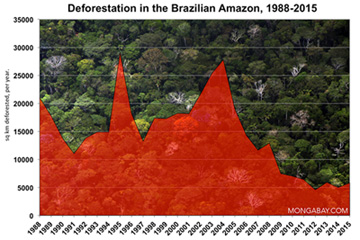Brazil to cut Amazon deforestation by 70% to fight global warming
mongabay.com
December 1, 2008
Brazil will aim to cut its deforestation rate to 5,860 square kilometers (2,260 square miles) per year by 2018 under its plan to reduce emissions from forest clearing, said Environment Minister Carlos Minc. For comparison, forest loss for the August 2007-July 2008 period was 11,968 square kilometers (4,621 square miles).
The plan will be financed by the country’s Amazon Fund which relies on voluntary contributions from governments, corporations, and wealthy individuals. Norway has pledged up to a billion dollars to the fund depending on Brazil’s effectiveness in reducing deforestation. Contributors are not eligible for carbon credits.

|
To meet its goals, the Brazilian government will promote reforestation and sustainable development, while continuing its crackdown on illegal logging in the Amazon. Minc said 3,000 officers would be added in the region.
The announced target was below expectations. Speaking in late September Minc seemed to suggest the country would aim for zero “net deforestation” by 2015. The focus on net deforestation — under both targets — may allow Brazil to offset cleared forest with reforestation, enabling the conversion of old-growth forests for industrial plantations. The government is weighing a proposal to allow landowners to include oil palm plantations as part of their legal forest reserve. Brazilian law requires landowners in the Brazilian Amazon to maintain 80 percent of the forest cover on their land and the change could allow ranchers and farmers to legally covert up to 30 percent of their holdings for the oilseed, which is used to produce palm oil. An emphasis on plantations in the plan would be significant in that they are deficient in terms of biodiversity and carbon storage relative to natural forests, meaning that the area of forest planted with tree crops would have to exceed the area deforested in order to balance emissions.
The target comes under Brazil’s National Climate Change Plan which aims to reduce the country’s greenhouse gas emissions, about 55 percent of which result from deforestation (another 20 percent results from other land use).
Brazil estimates that the new plan will reduce emissions 70 percent relative to the 1996-2005 baseline of 19,533 square kilometers of forest loss per year. Achieving these targets would avoid 4.8 billion tons of CO2 emissions during 2006-2017, a total greater than the annual emissions of the E.U. and Canada combined.
Forest clearing in Brazil is increasingly the result of industrial activities, namely logging and subsequent conversion for cattle pasture. Suitable grazing land is often planted with soy or other crops.
Related articles
Amazon deforestation rises slightly to 4,600 square miles in 2008
(11/28/2008) Deforestation in the Brazilian Amazon increased slightly for the August 2007-July 2008 period, reports the country’s National Institute of Space Research (INPE). The rise is the first since 2004 when 27,379 square kilometers were destroyed, but is lower than forecast. The 2008 figure is the second-lowest annual loss since 1991.
Future threats to the Amazon rainforest
(7/31/2008) Between June 2000 and June 2008, more than 150,000 square kilometers of rainforest were cleared in the Brazilian Amazon. While deforestation rates have slowed since 2004, forest loss is expected to continue for the foreseeable future. This is a look at past, current and potential future drivers of deforestation in the Brazilian Amazon.














